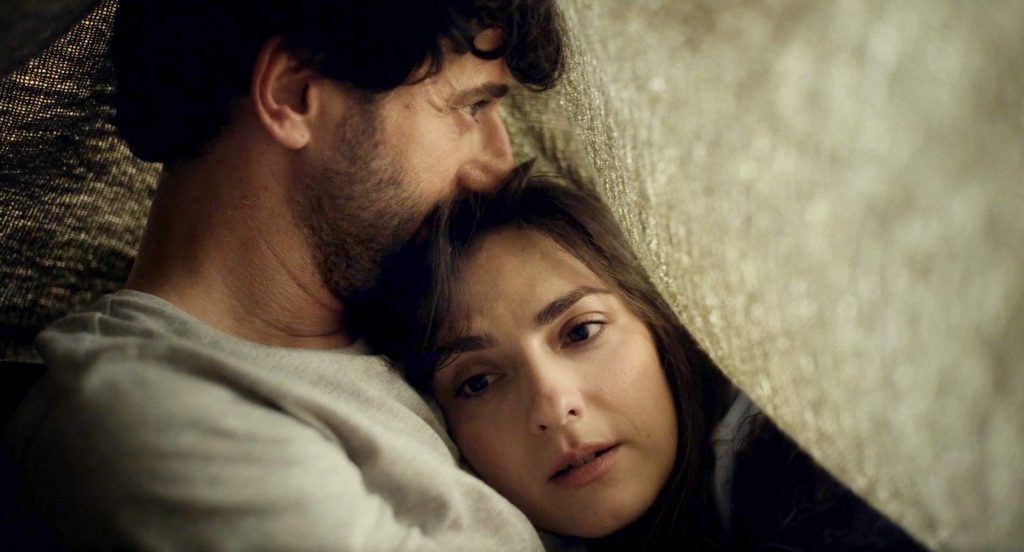Haunting love story about a husband who has to come to terms with the fact that his wife was shot dead by a stranger.
FAST FACTS:
• Touching German love story with an emphasized political dimension
• Convincing leading actors: Serkan Kaya and Seyneb Saleh
• World premiere at the Hamburg Film Festival in the Große Freiheit series
•Award for best actor at the 28th Film Festival Turkey Germany in Nuremberg
CREDITS:
Country/Year: Germany 2023; Length: 100 minutes; Director & Screenplay: Kanwal Sethi; Cast: Serkan Kaya, Seyneb Saleh, Amira Demirkiran, Olga von Luckwald, Marietta Meguid, Milian Zerzawy, Birte Schnöink; Distribution: Filmwelt; Release: May 2, 2024
REVIEW:
The NSU murders were the starting point for Fatih Akin’s „Out of Nothing“ in 2017. And are now also deeply interwoven in the DNA of the new film by Indian-German director Kanwal Sethi („Once Again – A Love in Mumbai“, part one of a trilogy about loneliness in urban India, which the filmmaker plans to continue this year), a production by Benny Drechsel with his Rohfilm, which celebrated its world premiere last year as part of the Hamburg Film Festival and won Serkan Kaya the award for best actor at the 28th Film Festival Turkey Germany in Nuremberg in March. And yet the two films have little in common beyond that: one is a political courtroom thriller, the other an unusual love story. Whereby Sethi uses his story of the love between Ilyas and Yasemin, he a Berliner with Turkish roots, she a Cologne woman of Kurdish origin, to peek into the cracks and tell us something about systemic racism in Germany: And no matter how German you may feel, as a genuine Berliner, in the eyes of the authorities you will always remain the other, the foreigner.

But first comes love. Ilyas and Yasemin get to know each other on a boat trip on the Spree. There is an immediate deep understanding, as if they have known someone forever, inside and out, even if he is a little embarrassed when she leans over the railing and shouts into the night that she is a Kanak. It would never occur to him, he, who has always lived in Germany, doesn’t see himself that way. 15 years later, the two have built up a middle-class existence together, with a flourishing café: a beautiful, large apartment, tastefully furnished, always elegantly dressed. They have a 14-year-old daughter together. There is a certain amount of stress in the air, you can feel it, and yet it comes as a shock to the viewer and Ilyas when Yasemin is shot dead by an unknown man in the café.
Kanwal Sethi observes with the necessary distance how a man deals with the fact that from one moment to the next everything that makes up his life is taken from him, how he stands before the pile of rubble, before a yawning emptiness. And how he has to carry on in spite of this, in spite of his daughter and his family. Even if it is not made easy for him, because the police leave no doubt that they always suspect him and blame the victim: did Ilyas know that Yasemin regularly donated money to organizations that support the PKK? Doubt is a slow-acting poison, constant dripping wears away the stone: could it be that after 15 years he knew his wife less than he did when they fell in love on that balmy summer night? And then there is the tone that is struck towards him, the looks that are thrown at him, the reaction of the public when the news gets wind of Yasemin’s possible contacts. Suddenly it feels a bit like Kafka. Or at least like Hitchcock: however you react, somehow you automatically slip deeper and deeper into something that had never been an issue before.
The fact that „Was von der Liebe bleibt“ can sometimes seem a little didactic is always cushioned by the convincing acting of Serkan Kaya and Seyneb Saleh in the leading roles, two attractive and likeable characters, she perhaps with more depths than one might suspect, he confronted with the realization that although he has always identified himself as a „Berliner“ and has never perceived himself otherwise, in the eyes of the people he meets he is probably always a „Kanake“. The last scene in particular underlines this; as a viewer, you are stunned because you have to admit it: Yes, that’s how it is. At the very beginning we see Ilyas lying motionless on a bench on a bridge, snow, cold, gray in gray. Then the film, shot by Danish cinematographer Erik Molberg Hansen (who also took the film’s stills) with selected precision and color-coded photography, jumps to summer, to bright colors that only appear later when we see Yasemin in flashbacks in her colorful clothes. Apart from that, Sethi and Molberg increasingly drive the color out of their images, lots of brown and even more blue, especially when police officers are seen. Until only grey remains, Germany’s primary color: it bends the hero of the film. But it doesn’t break him. Because there is no question that love remains.
Thomas Schultze
